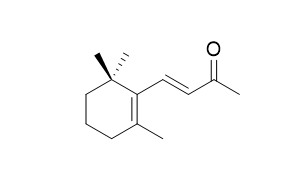4-(2,6,6-Trimethyl-1-cyclohexenyl)-3-buten-2-one
Reference standards.
Inquire / Order:
manager@chemfaces.com
Technical Inquiries:
service@chemfaces.com
Tel:
+86-27-84237783
Fax:
+86-27-84254680
Address:
1 Building, No. 83, CheCheng Rd., Wuhan Economic and Technological Development Zone, Wuhan, Hubei 430056, PRC
Providing storage is as stated on the product vial and the vial is kept tightly sealed, the product can be stored for up to
24 months(2-8C).
Wherever possible, you should prepare and use solutions on the same day. However, if you need to make up stock solutions in advance, we recommend that you store the solution as aliquots in tightly sealed vials at -20C. Generally, these will be useable for up to two weeks. Before use, and prior to opening the vial we recommend that you allow your product to equilibrate to room temperature for at least 1 hour.
Need more advice on solubility, usage and handling? Please email to: service@chemfaces.com
The packaging of the product may have turned upside down during transportation, resulting in the natural compounds adhering to the neck or cap of the vial. take the vial out of its packaging and gently shake to let the compounds fall to the bottom of the vial. for liquid products, centrifuge at 200-500 RPM to gather the liquid at the bottom of the vial. try to avoid loss or contamination during handling.
Mol Med Rep.2022, 25(1):8.
Int J Mol Sci.2020, 21(7):2530.
Am J Chin Med.2023, 51(4):1019-1039.
Sustainability2021, 13(23),12981.
Plants (Basel).2021, 10(6):1119.
Int J Biol Macromol.2021, 199:189-200.
J Korean Med Obes Res.2023, 23:10-7
Current Topics in Nutraceutical Research2021, 19(1),p90-105.
Oncology Letters2018, 4690-4696
Antioxidants (Basel).2024, 13(8):951.
Related and Featured Products
Journal of Tea, 2013(04):112-116.
Volatile Compounds in Two Camellia chrysantha(Hu)Tuyama Species.[Reference:
WebLink]
In the study, the volatile compounds in two Camellia chrysantha(Hu) Tuyama species were extracted and analysed by simultaneous steam distillation and extraction(SDE) and gas chromatography mass spectrometry(GCMS),respectively.
METHODS AND RESULTS:
The relative contents of the chemical constituents in the volatile components were quantified by peak area normalization and NIST database.A total of 60 volatile components were identified,45 for Camellia nitidissima and 26 for Camellia euphlebia.Aldehydes and acids were the most dominant volatiles in Camellia nitidissima,but for Camellia euphlebia there were hydrocarbons and ketones.Hexanoic acid, 4-(2,6,6-Trimethyl-1-cyclohexenyl)-3-buten-2-one ,cis-2-decenal,4-[2,2,6-trimethyl-7-oxabicyclo[4.1.0]hept-1-yl]-3-buten-2-one,phenylacetaldehyde,eicosane,alpha-ionone,geranylacetone 2,6-di-tert-butyl-4-methylphenol,7,9-di-tertbutyl-1-oxaspiro[4,5]deca-6,9-diene-2,8-dioi and tetradecanal were both in two Camellia chrysantha(Hu)Tuyama species.



